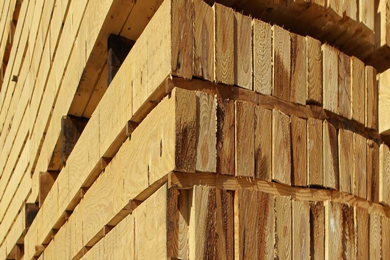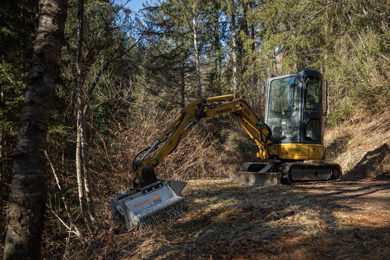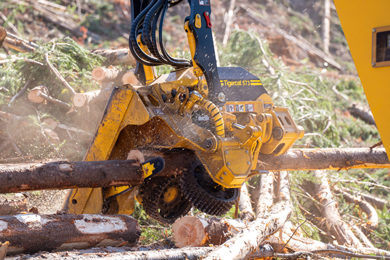Until about six months ago, B.C.’s forestry companies were riding a lumber bull market.
Record-high lumber prices in the U.S. had muted softwood lumber duties, and B.C. forestry companies were netting record profits.
But the party may be over reports Nelson Bennett, BIV.
A shrinking timber supply and high log prices in B.C. and a sudden drop in lumber prices in the U.S. have created a sudden bear market for B.C. sawmills.
“We think the majority of those folks are going to be able to land in other opportunities within our company in our other operations,” James Gorman, vice-president of government and corporate relations for West Fraser Timber, told Business in Vancouver. “But at the end of the day, that’s still 135 positions that won’t exist in British Columbia in the forest industry.”
Starting in January, West Fraser will take about 300 million board feet out of production – roughly 13% of West Fraser’s B.C. production.
Almost all other major forestry companies are also cutting production in the fourth quarter, including Conifex Timber Inc. (TSX:CFF), Tolko Industries, Canfor Corp. (TSX:CFP) and Interfor Corp. (TSX:IFP).
Tolko announced last month that it would lay off 100 workers at its Quesnel sawmill, and on November 9 Conifex announced that it is temporarily curtailing its production at its Fort St. James sawmill for two weeks, affecting 180 to 200 workers.
Last month, Interfor announced it would reduce production at all three of its B.C. Interior mills, and on November 1, Canfor announced it was curtailing production at all of its B.C. sawmills.
Two weeks ago, Teal Jones Group shut down sawmills for one week – its seventh one-week curtailment this year.
“The lack of availability of logs was the main driver for us taking the downtime,” said Teal Jones CFO Hanif Karmally, adding that the level of raw log exports is a contributing factor.
The recent curtailment announcements came at a time when B.C. forestry companies were announcing hundreds of millions of dollars in acquisitions outside of Canada. Tolko recently announced it is taking a 50% stake in a lumber mill in Mississippi, and Canfor announced November 9 that it is buying a sawmill in South Carolina for $110 million. And, on November 15, Canfor announced it is investing $580 million to take a 70% stake in a Swedish lumber company.
American lumber prices have fallen by roughly half since May: to just over US$300 per 1,000 board feet from nearly US$600.
The higher lumber prices had muted the impacts of U.S. softwood lumber duties. But now that prices have fallen, companies will be feeling the pinch.
“When you’ve got scarce fibre, which pushes prices for it up, and then you’re paying duties on top of that, and your market price has declined significantly, that puts companies into the bite,” said Susan Yurkovich, president and CEO of the Council of Forest Industries. “And that’s why you’re seeing announcements about curtailments, either temporary or permanent.”
It’s not lower lumber prices in the U.S. so much as high log prices in B.C. that are the biggest problem for companies operating in this province.
“Timber prices in British Columbia are now among the highest in North America, and that’s a result of too many mills chasing too few trees,” Gorman said.
The mountain pine beetle infestation, which started more than 20 years ago, has been a short-term blessing and a long-term curse for B.C. forestry companies.
A surplus of dead and dying trees meant a timber supply bonanza. But most of that beetle-killed timber has been used, and more recently wildfires have taken a bite out of an already shrinking annual allowable cut (AAC).
Fires in 2017 took 22% out of the AAC for Quesnel and 18% for Williams Lake, for example.
Doug Donaldson, minister of forests, lands and natural resource operations, was unavailable to comment on government policies on the annual allowable cut or log exports. But Gorman said there’s not much the provincial government can do about the problem anyway.
Forestry companies have known for about a decade that a long-term decline in B.C.’s AAC was coming, which explains why so many B.C. companies have been investing in sawmills in the U.S., where there is still an adequate timber supply. The biggest players now own more sawmills in the U.S. than in Canada.
David Elstone, executive director of the Truck Loggers Association, which represents logging companies, said sawmill curtailments will affect loggers, depending on how long they last.
“The scary aspect of this whole story is, while the balance sheets have been repaired through the good times for the sawmills,… contractors are left with balance sheets that have not grown any fatter. It just means we’re probably going to have a lot less contractors when it comes out the other side here.”
The “other side” could be 2075. That’s when the AAC in B.C. is expected to return to normal.
In 1987, B.C.’s AAC peaked at 90 million cubic metres. The long-term forecast is for an AAC of 58 million cubic metres by 2025. The AAC is expected to return to between 65 million and 70 million cubic feet around 2075.
Meanwhile, over the next decade, demand for lumber in the U.S. is expected to remain strong, and Canada will continue to be its main supplier, according to a recent report by ForestEdge LLC and Wood Resources International LLC. But Eastern Canada, not B.C., will fill that role.
Canfor expands with Swedish acquisition
Vancouver-headquartered Canfor Corp. (TSX:CFP) is now an international forestry company, thanks to the acquisition of a Swedish lumber company.
Canfor last week announced plans to acquire 70% of Vida Group for $580 million. Vida owns nine sawmills in Sweden and produces 1.1 billion board feet per year.
Over the years, Canfor’s expansion outside of B.C. has mainly been in the U.S. and other parts of Canada. The Swedish acquisition expands Canfor’s customer base and positions it as an international wood manufacturer.
Canfor CEO Don Kayne acknowledged that B.C.’s shrinking annual allowable cut (AAC) is partly behind the expansion outside of North America, but he added that market access was the main consideration.
“More importantly, I think this has been driven more by our customers and their desire to see Canfor grow with them.”
Kayne added that most of Canfor’s production still comes from Canada, and the bulk of that is from its B.C. sawmills and pulp mills.
He said Canfor still believes B.C. is well positioned geographically to grow in the long term in the Asian and U.S. markets, but Kayne added that the reduced AAC resulting from forest fires and the mountain pine beetle infestation limited opportunities to expand in B.C.
Kayne said Canfor’s customer base is global and the company needs to ensure a reliable supply of quality wood products.
nbennett@biv.com
@nbennett_biv
https://twitter.com/nbennett_biv
Photo The Teal-Jones Group provides customers around the world with top quality wood products







